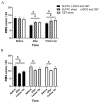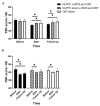Does Multisession Cathodal Transcranial Direct Current Stimulation of the Left Dorsolateral Prefrontal Cortex Prime the Effects of Cognitive Behavioral Therapy on Fear of Pain, Fear of Movement, and Disability in Patients with Nonspecific Low Back Pain? A Randomized Clinical Trial Study
- PMID: 37891750
- PMCID: PMC10605034
- DOI: 10.3390/brainsci13101381
Does Multisession Cathodal Transcranial Direct Current Stimulation of the Left Dorsolateral Prefrontal Cortex Prime the Effects of Cognitive Behavioral Therapy on Fear of Pain, Fear of Movement, and Disability in Patients with Nonspecific Low Back Pain? A Randomized Clinical Trial Study
Abstract
Many studies have shown that low back pain (LBP) is associated with psychosomatic symptoms which may lead to brain changes. This study aimed to investigate the effect of the concurrent application of cognitive behavioral therapy (CBT) and transcranial direct electrical stimulation (tDCS) over the left dorsolateral prefrontal cortex (DLPFC) on fear of pain, fear of movement, and disability in patients with nonspecific LBP. This study was performed on 45 LBP patients (23 women, 22 men; mean age 33.00 ± 1.77 years) in three groups: experimental (2 mA cathodal tDCS (c-tDCS)), sham (c-tDCS turned off after 30 s), and control (only received CBT). In all groups, CBT was conducted for 20 min per session, with two sessions per week for four weeks. Fear of pain, fear of movement, and disability were evaluated using questionnaires at baseline, immediately after, and one month after completion of interventions. Results indicated that all three different types of intervention could significantly reduce fear and disability immediately after intervention (p > 0.05). However, improvement in the experimental group was significantly higher than in the other groups immediately after and at the one-month follow-up after interventions (p < 0.05). DLPFC c-tDCS can prime the immediate effects of CBT and also the lasting effects on the reduction in the fear of pain, fear of movement, and disability in LBP patients.
Keywords: cognition; disability; fear; left dorsolateral prefrontal cortex; low back pain; transcranial direct electrical stimulation.
Conflict of interest statement
The authors declare that there are no conflict of interest.
Figures





References
-
- Twomey L.T., Taylor J.R. Physical Therapy of the Low Back. Churchill Livingstone; London, UK: 2000.
LinkOut - more resources
Full Text Sources
Miscellaneous

